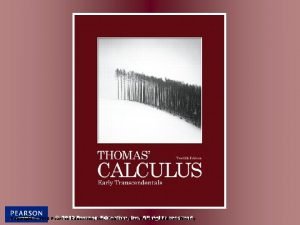Copyright 2010 Pearson Education Inc All rights reserved































- Slides: 31

Copyright © 2010 Pearson Education, Inc. All rights reserved Sec 5. 3 - 1

Chapter 5 Systems of Linear Equations Copyright © 2010 Pearson Education, Inc. All rights reserved Sec 5. 3 - 2

5. 3 Applications of Systems of Linear Equations Copyright © 2010 Pearson Education, Inc. All rights reserved Sec 5. 3 - 3

5. 3 Applications of Systems of Linear Equations Objectives 1. Solve geometry problems using two variables. 2. Solve money problems using two variables. 3. Solve mixture problems using two variables. 4. Solve distance-rate-time problems using two variables. 5. Solve problems with three variables using a system of three equations. Copyright © 2010 Pearson Education, Inc. All rights reserved. Sec 5. 3 - 4

5. 3 Applications of Systems of Linear Equations Solving an Applied Problem by Writing a System of Equations Step 1 Read the problem, several times if necessary, until you understand what is given and what is to be found. Step 2 Assign variables to represent the unknown values, using diagrams or tables as needed. Write down what each variable represents. Step 3 Write a system of equations that relates the unknowns. Step 4 Solve the system of equations. Step 5 State the answer to the problem. Does it seem reasonable? Step 6 Check the answer in the words of the original problem. Copyright © 2010 Pearson Education, Inc. All rights reserved. Sec 5. 3 - 5

5. 3 Applications of Systems of Linear Equations EXAMPLE 1 Finding the Dimensions of a Parking Lot The length of a rectangular parking lot is 20 ft more than three times its width. The perimeter of the parking lot is 800 ft. What are the dimensions of the parking lot? Step 1 Read the problem again. We must find the dimensions of the parking lot. Step 2 Assign variables. Let L = the length and W = the width. L W Copyright © 2010 Pearson Education, Inc. All rights reserved. Sec 5. 3 - 6

5. 3 Applications of Systems of Linear Equations EXAMPLE 1 Finding the Dimensions of a Parking Lot The length of a rectangular parking lot is 20 ft more than three times its width. The perimeter of the parking lot is 800 ft. What are the dimensions of the parking lot? Step 3 Write a system of equations. Because the perimeter is 800 ft, we find one equation by using the perimeter formula: 2 L + 2 W = 800. Because the length is 20 ft more than three times its width, we have L = 3 W + 20. The system is, therefore, 2 L + 2 W = 800 (1) L = 3 W + 20. (2) Copyright © 2010 Pearson Education, Inc. All rights reserved. Sec 5. 3 - 7

5. 3 Applications of Systems of Linear Equations EXAMPLE 1 Finding the Dimensions of a Parking Lot The length of a rectangular parking lot is 20 ft more than three times its width. The perimeter of the parking lot is 800 ft. What are the dimensions of the parking lot? Step 4 Solve the system of equations. We substitute 3 W + 20 for L, in equation (1), and solve for W. 2 L + 2 W = 800 2(3 W + 20) + 2 W = 800 6 W + 40 + 2 W = 800 8 W + 40 = 800 (1) Let L = 3 W + 20. Distributive property Combine terms. 8 W = 760 Subtract 40. W = 95 Divide by 8. Copyright © 2010 Pearson Education, Inc. All rights reserved. Sec 5. 3 - 8

5. 3 Applications of Systems of Linear Equations EXAMPLE 1 Finding the Dimensions of a Parking Lot The length of a rectangular parking lot is 20 ft more than three times its width. The perimeter of the parking lot is 800 ft. What are the dimensions of the parking lot? Step 4 Solve the system of equations. We just solved the equation 2 L + 2 W = 800 and found W = 95. Now, let W = 95 in the equation L = 3 W + 20 to find L. L = 3 W + 20 L = 3(95) + 20 Let W = 95. L = 305 Copyright © 2010 Pearson Education, Inc. All rights reserved. Sec 5. 3 - 9

5. 3 Applications of Systems of Linear Equations EXAMPLE 1 Finding the Dimensions of a Parking Lot The length of a rectangular parking lot is 20 ft more than three times its width. The perimeter of the parking lot is 800 ft. What are the dimensions of the parking lot? Step 5 State the answer. The length is 305 ft and the width is 95 ft. Step 6 Check. The perimeter is 2(305) + 2(95) = 800 ft, and the length, 305 ft, is 20 ft more than three times the width, since 3(95) + 20 = 305. The answer is correct. Copyright © 2010 Pearson Education, Inc. All rights reserved. Sec 5. 3 - 10

5. 3 Applications of Systems of Linear Equations EXAMPLE 2 Solving a Problem about Prices At a local restaurant, the price of 1 soft drink and 2 hamburgers is $12. 15 and the price of 5 EXAMPLE soft drinks and 2 4 hamburgers is $32. 25. Find the price of a single hamburger and a soft drink. Step 1 Read the problem again. There are two unknowns. Step 2 Assign variables. Let s represent the price of one soft drink and h represent the price of one hamburger. Copyright © 2010 Pearson Education, Inc. All rights reserved. Sec 5. 3 - 11

5. 3 Applications of Systems of Linear Equations EXAMPLE 2 Solving a Problem about Prices At a local restaurant, the price of 1 soft drink and 2 hamburgers is $12. 15 and the price of 5 EXAMPLE soft drinks and 2 4 hamburgers is $32. 25. Find the price of a single hamburger and a soft drink. Step 3 Write a system of equations. Because one soft drink and 2 hamburgers cost a total of $12. 15, one equation for the system is s + 2 h = 12. 15. By similar reasoning, the second equation is 5 s + 4 h = 32. 25. Therefore, the system is s + 2 h = 12. 15 5 s + 4 h = 32. 25. Copyright © 2010 Pearson Education, Inc. All rights reserved. (1) (2) Sec 5. 3 - 12

5. 3 Applications of Systems of Linear Equations EXAMPLE 2 Solving a Problem about Prices At a local restaurant, the price of 1 soft drink and 2 hamburgers is $12. 15 and the price of 5 EXAMPLE soft drinks and 2 4 hamburgers is $32. 25. Find the price of a single hamburger and a soft drink. Step 4 Solve the system of equations. s + 2 h = 12. 15 5 s + 4 h = 32. 25 – 5 s – 10 h = – 60. 75 5 s + 4 h = 32. 25 – 6 h = – 28. 50 h = 4. 75 Copyright © 2010 Pearson Education, Inc. All rights reserved. (1) (2) Multiply each side of (1) by – 5. (2) Add. Divide by – 6. Sec 5. 3 - 13

5. 3 Applications of Systems of Linear Equations EXAMPLE 2 Solving a Problem about Prices At a local restaurant, the price of 1 soft drink and 2 hamburgers is $12. 15 and the price of 5 EXAMPLE soft drinks and 2 4 hamburgers is $32. 25. Find the price of a single hamburger and a soft drink. Step 4 Solve the system of equations. We just found h = 4. 75. Now, let h = 4. 75 in the equation s + 2 h = 12. 15 to find s. s + 2 h = 12. 15 s + 2(4. 75) = 12. 15 s + 9. 50 = 12. 15 s = 2. 65 Copyright © 2010 Pearson Education, Inc. All rights reserved. (1) Let h = 4. 75. Multiply. Subtract 9. 50. Sec 5. 3 - 14

5. 3 Applications of Systems of Linear Equations EXAMPLE 2 Solving a Problem about Prices At a local restaurant, the price of 1 soft drink and 2 hamburgers is $12. 15 and the price of 5 EXAMPLE soft drinks and 2 4 hamburgers is $32. 25. Find the price of a single hamburger and a soft drink. Step 5 State the answer. The price of a single soft drink is $2. 65 and the price of a hamburger is $4. 75. Step 6 Check that these values satisfy the conditions stated in the problem. 5(2. 65) 1(2. 65) + Copyright © 2010 Pearson Education, Inc. All rights reserved. 4(4. 75) 2(4. 75) = $32. 25 $12. 15 Sec 5. 3 - 15

5. 3 Applications of Systems of Linear Equations EXAMPLE 3 Solving a Mixture Problem How many ounces each of 10% hydrochloric acid and 25% hydrochloric acid must be combined to get 40 oz of solution that is 22% hydrochloric acid? Step 1 Read the problem. Two solutions of different strengths are being mixed together to get a specific amount of a solution with an “inbetween” strength. Step 2 Assign a variable. Let x = the number of ounces of 10% solution and y = the number of ounces of 25% solution. 10% x oz + 25% y oz Copyright © 2010 Pearson Education, Inc. All rights reserved. = 25% 22% 10% 40 oz Sec 5. 3 - 16

5. 3 Applications of Systems of Linear Equations EXAMPLE 3 Solving a Mixture Problem How many ounces each of 10% hydrochloric acid and 25% hydrochloric acid must be combined to get 40 oz of solution that is 22% hydrochloric acid? Step 2 Assign a variable. Let x = the number of ounces of 10% solution and y = the number of ounces of 25% solution. Percent (as a decimal) Number of Ounces of Pure Acid 10% = 0. 10 x 0. 10 x 25% = 0. 25 y 0. 25 y 22% = 0. 22 40 0. 22(40) Step 3 Write a system of equations. 10% x oz + x y == + 25%. 10 x +. 25 y = y oz Copyright © 2010 Pearson Education, Inc. All rights reserved. 40 22% 8. 8 40 oz (1) (2) Sec 5. 3 - 17

5. 3 Applications of Systems of Linear Equations EXAMPLE 3 Solving a Mixture Problem How many ounces each of 10% hydrochloric acid and 25% hydrochloric acid must be combined to get 40 oz of solution that is 22% hydrochloric acid? Step 4 Solve the system. – 10 x x = 40 (1) 0. 10 x + 0. 25 y = 8. 8 (2) y + + – 10 y = – 400 Multiply each side of (1) by – 10. 25 y = 880 Multiply each side of (2) by 100. 15 y = 480 Add. y = 32 + Divide by 15. Because y = 32 and x + y = 40, x = 8. Copyright © 2010 Pearson Education, Inc. All rights reserved. Sec 5. 3 - 18

5. 3 Applications of Systems of Linear Equations EXAMPLE 3 Solving a Mixture Problem How many ounces each of 10% hydrochloric acid and 25% hydrochloric acid must be combined to get 40 oz of solution that is 22% hydrochloric acid? Step 5 State the answer. The desired mixture will require 8 oz of the 10% solution and 32 oz of the 25% solution. Step 6 Check that these values satisfy both equations of the system. Percent (as a decimal) Number of Ounces of Pure Acid 0. 10 8 0. 25 32 8 0. 22 40 8. 8 Copyright © 2010 Pearson Education, Inc. All rights reserved. Sec 5. 3 - 19

5. 3 Applications of Systems of Linear Equations EXAMPLE 4 Solving a Motion Problem A car travels at 310 miles in the same time that a bus travels 290 miles. If the speed of the car is 4 mph faster than the speed of the bus, find both speeds. Step 1 Read the problem again. Given the distances traveled, we need to find the speed of each vehicle. Step 2 Assign variables. Let x = the speed of the car and y = the speed of the bus. Since d = rt, t = dr. distance (d) rate (r) time (t) Car 310 x Bus 290 y Copyright © 2010 Pearson Education, Inc. All rights reserved. Sec 5. 3 - 20

5. 3 Applications of Systems of Linear Equations EXAMPLE 4 Solving a Motion Problem A car travels at 310 miles in the same time that a bus travels 290 miles. If the speed of the car is 4 mph faster than the speed of the bus, find both speeds. Step 3 Write a system of equations. The problem states that the car travels 4 mph faster than the bus. Since the two speeds are x and y, x = y + 4. Both vehicles travel for the same time, so from the table 310 = 290. Multiplying both sides by xy gives 310 y = 290 x. x y distance (d) rate (r) time (t) Car 310 x Bus 290 y Copyright © 2010 Pearson Education, Inc. All rights reserved. Sec 5. 3 - 21

5. 3 Applications of Systems of Linear Equations EXAMPLE 4 Solving a Motion Problem A car travels at 310 miles in the same time that a bus travels 290 miles. If the speed of the car is 4 mph faster than the speed of the bus, find both speeds. Step 4 Solve the system of equations using substitution. x = y + 4 310 y = 290 x (1) (2) 310 y = 290 x (2) 310 y = 290( y + 4) Let x = y + 4. 310 y = 290 y + 1160 Distributive property 20 y = 1160 y = 58 Subtract 290 y. Divide by 20. Because x = y + 4, the value of x is 58 + 4 = 62. Copyright © 2010 Pearson Education, Inc. All rights reserved. Sec 5. 3 - 22

5. 3 Applications of Systems of Linear Equations EXAMPLE 4 Solving a Motion Problem A car travels at 310 miles in the same time that a bus travels 290 miles. If the speed of the car is 4 mph faster than the speed of the bus, find both speeds. Step 5 State the answer. The car’s speed is 62 mph, and the speed of the bus is 58 mph. Step 6 Check. This is especially important since one of the equations had variable denominators. Car: Bus: 310 t = dr = = 5 62 Times are equal. 290 t = dr = = 5 58 Since 62 – 58 = 4, the conditions of the problem are satisfied. Copyright © 2010 Pearson Education, Inc. All rights reserved. Sec 5. 3 - 23

5. 3 Applications of Systems of Linear Equations EXAMPLE 5 Solving a Problem Involving Prices At a local bakery, a loaf of honey wheat bread costs $2. 69, a loaf of sunflower bread costs $2. 89, and a loaf of French bread costs $3. 39. On a recent day, twice as many loaves of sunflower were sold as honey wheat. The number of loaves of French bread sold was three less than the number of loaves of sunflower. Total receipts for these breads were $96. 58. How many loaves of each type of bread were sold? Step 1 Read the problem again. There are three unknowns. Step 2 Assign variables to represent the three unknowns. Let x = number of loaves of honey wheat, y = number of loaves of sunflower, and z = number of loaves of French bread. Copyright © 2010 Pearson Education, Inc. All rights reserved. Sec 5. 3 - 24

5. 3 Applications of Systems of Linear Equations EXAMPLE 5 Solving a Problem Involving Prices At a local bakery, a loaf of honey wheat bread costs $2. 69, a loaf of sunflower bread costs $2. 89, and a loaf of French bread costs $3. 39. On a recent day, twice as many loaves of sunflower were sold as honey wheat. The number of loaves of French bread sold was three less than the number of loaves of sunflower. Total receipts for these breads were $96. 58. How many loaves of each type of bread were sold? Step 3 Write a system of equations. x = loaves of honey wheat, y = loaves of sunflower, z = loaves of French bread y = 2 x, or y – 2 x = 0 (1) z = y – 3, or z – y = – 2 (2) 2. 69 x + 2. 89 y + 3. 39 z = 96. 58 Copyright © 2010 Pearson Education, Inc. All rights reserved. (3) Sec 5. 3 - 25

5. 3 Applications of Systems of Linear Equations EXAMPLE 5 Solving a Problem Involving Prices At a local bakery, a loaf of honey wheat bread costs $2. 69, a loaf of sunflower bread costs $2. 89, and a loaf of French bread costs $3. 39. On a recent day, twice as many loaves of sunflower were sold as honey wheat. The number of loaves of French bread sold was three less than the number of loaves of sunflower. Total receipts for these breads were $96. 58. How many loaves of each type of bread were sold? Step 4 Solve the system of three equations using substitution. y = 2 x (1) z = y – 3 (2) z = 2 x – 3 Copyright © 2010 Pearson Education, Inc. All rights reserved. Let y = 2 x. (4) Sec 5. 3 - 26

5. 3 Applications of Systems of Linear Equations EXAMPLE 5 Solving a Problem Involving Prices At a local bakery, a loaf of honey wheat bread costs $2. 69, a loaf of sunflower bread costs $2. 89, and a loaf of French bread costs $3. 39. On a recent day, twice as many loaves of sunflower were sold as honey wheat. The number of loaves of French bread sold was three less than the number of loaves of sunflower. Total receipts for these breads were $96. 58. How many loaves of each type of bread were sold? Step 4 Solve the system of three equations using substitution. y = 2 x (1) z = 2 x – 3 (4) 269 x + 289 y + 339 z = 9658 Multiply each side (3) by 100. 269 x + 289(2 x) + 339(2 x – 3) = 9658 Copyright © 2010 Pearson Education, Inc. All rights reserved. Substitute in (3). Sec 5. 3 - 27

5. 3 Applications of Systems of Linear Equations EXAMPLE 5 Solving a Problem Involving Prices At a local bakery, a loaf of honey wheat bread costs $2. 69, a loaf of sunflower bread costs $2. 89, and a loaf of French bread costs $3. 39. On a recent day, twice as many loaves of sunflower were sold as honey wheat. The number of loaves of French bread sold was three less than the number of loaves of sunflower. Total receipts for these breads were $96. 58. How many loaves of each type of bread were sold? Step 4 Solve the system of three equations using substitution. 269 x + 578 x + 678 x – 1017 = 9658 1525 x = 10, 675 x = 7 Copyright © 2010 Pearson Education, Inc. All rights reserved. Multiply & distribute. Combine terms. Add 1017. Divide by 1525. Sec 5. 3 - 28

5. 3 Applications of Systems of Linear Equations EXAMPLE 5 Solving a Problem Involving Prices At a local bakery, a loaf of honey wheat bread costs $2. 69, a loaf of sunflower bread costs $2. 89, and a loaf of French bread costs $3. 39. On a recent day, twice as many loaves of sunflower were sold as honey wheat. The number of loaves of French bread sold was three less than the number of loaves of sunflower. Total receipts for these breads were $96. 58. How many loaves of each type of bread were sold? Step 4 Solve the system of three equations using substitution. Because x = 7 and y = 2 x, y = 14. Also, because y = 14 and z = y – 3, z = 11. Copyright © 2010 Pearson Education, Inc. All rights reserved. Sec 5. 3 - 29

5. 3 Applications of Systems of Linear Equations EXAMPLE 5 Solving a Problem Involving Prices At a local bakery, a loaf of honey wheat bread costs $2. 69, a loaf of sunflower bread costs $2. 89, and a loaf of French bread costs $3. 39. On a recent day, twice as many loaves of sunflower were sold as honey wheat. The number of loaves of French bread sold was three less than the number of loaves of sunflower. Total receipts for these breads were $96. 58. How many loaves of each type of bread were sold? Step 5 State the answer. The solution set is { (7, 14, 11) }, meaning that 7 loaves of honey wheat, 14 loaves of sunflower, and 11 loaves of French bread were sold. Copyright © 2010 Pearson Education, Inc. All rights reserved. Sec 5. 3 - 30

5. 3 Applications of Systems of Linear Equations EXAMPLE 5 Solving a Problem Involving Prices At a local bakery, a loaf of honey wheat bread costs $2. 69, a loaf of sunflower bread costs $2. 89, and a loaf of French bread costs $3. 39. On a recent day, twice as many loaves of sunflower were sold as honey wheat. The number of loaves of French bread sold was three less than the number of loaves of sunflower. Total receipts for these breads were $96. 58. How many loaves of each type of bread were sold? Step 6 Check. Since 14 = 2(7), the number of loaves of sunflower sold is twice the number of loaves as honey wheat. Also, 14 – 3 = 11, so the number of loaves of French bread is three less than the number of loaves of sunflower. The total from the receipts is $96. 58 as stated. 2. 69(7) + 2. 89(14) + 3. 39(11) = 96. 58. Copyright © 2010 Pearson Education, Inc. All rights reserved. Sec 5. 3 - 31
 2012 pearson education inc
2012 pearson education inc Pearson education inc. all rights reserved
Pearson education inc. all rights reserved 2010 pearson education inc
2010 pearson education inc Pearson education inc all rights reserved
Pearson education inc all rights reserved 2010 pearson education inc
2010 pearson education inc Copyright 2010 pearson education inc
Copyright 2010 pearson education inc Copyright 2010 pearson education inc
Copyright 2010 pearson education inc Copyright 2010 pearson education inc
Copyright 2010 pearson education inc Copyright 2010 pearson education inc
Copyright 2010 pearson education inc Copyright 2010 pearson education inc
Copyright 2010 pearson education inc Copyright 2010 pearson education inc
Copyright 2010 pearson education inc 2010 pearson education inc
2010 pearson education inc Copyright 2010 pearson education inc
Copyright 2010 pearson education inc Composition copyright example
Composition copyright example Copyright 2015 all rights reserved
Copyright 2015 all rights reserved Copyright © 2015 all rights reserved
Copyright © 2015 all rights reserved Dell all rights reserved copyright 2009
Dell all rights reserved copyright 2009 Copyright © 2018 all rights reserved
Copyright © 2018 all rights reserved 2017 pearson education inc
2017 pearson education inc Copyright by pearson education inc. answers
Copyright by pearson education inc. answers Copyright 2009 pearson education inc
Copyright 2009 pearson education inc Copyright pearson education inc
Copyright pearson education inc Copyright 2014 pearson education inc
Copyright 2014 pearson education inc Copyright by pearson education inc. answers
Copyright by pearson education inc. answers 2008 pearson education inc
2008 pearson education inc Copyright 2009 pearson education inc
Copyright 2009 pearson education inc Copyright pearson education inc
Copyright pearson education inc Copyright 2009 pearson education inc
Copyright 2009 pearson education inc 2009 pearson education inc
2009 pearson education inc Copyright 2009 pearson education inc
Copyright 2009 pearson education inc Copyright 2009 pearson education inc
Copyright 2009 pearson education inc Copyright pearson education inc
Copyright pearson education inc


















































